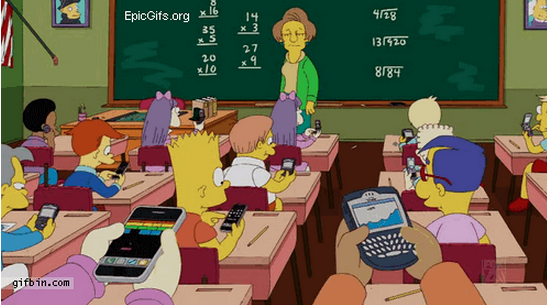
It is college visiting season again in our household… my younger son is now looking for the place to call home for the next 4 years. I actually enjoy these visits, although I am not sure the tour guides really like me there. I ask questions about language requirements and whether Financial Aid can be applied to Study Away and whether they have courses (outside of the silos of the language departments) where a knowledge of a foreign language can be useful.
I am also intrigued by what these tours show us (whether they mean to or not) about the use of technology in the classroom. Many tours are quick to announce that they have “Free Printing!” in the same breath as their extraordinary paper recycling efforts. Others talk about ubiquitous wireless and % of students who have laptops, as we walk by the back of a lecture classroom where 98% of the screens are open and connected to something other than what is on the whiteboard down below.
Raise your hand right now if during a faculty meeting, during a keynote address at a conference, heck, even while your students are working on something in small groups during class you have done the same thing…. been distracted and pulled off topic. Right. Yup, that would be all of us. So let’s be clear: it’s not just “them” and it’s not the fault of the tools….it happens to all of us.
So why do we continue to look for ways to punish our students vs thinking about creative ways to use technology in the classroom?
I am amazed by the articles that continue to be published about ways to control our students and their use of technology in the classroom. I read an article recently about a teacher creating a classroom policy in which students police one another and gain points towards their GPA if they “bust” another student for doing something off-task. Wow. Big brother is back, and he is stealing your points. Just wow.
Rather than perpetuating an us vs them dichotomy in the classroom, why not create effective and creative ways to keep students engaged, while using their portable technologies? Some examples of those kinds of activities might be…
• Workshopping papers: pull up student written documents in tools such as Google docs and ask students to give each other feedback, support, questions, praise…
• Online exercises and quizzes: it’s so easy to convince yourself you know everything when you do these kill and drill assignments on your own. Doing them with your peers might add the necessary impetus to not just sleepwalk your way through them.
• Being creative together: using tools like Five Card Flickr or Bubblr or Soundcloud even Voicethread in collaboration with others.
• Skype: Even though we love the Mixxer and know that not everyone on Skype is scary, sometimes having that first conversation with a native speakers accompanied by a couple of your classmates makes things easier.
Those are just a couple of ideas that popped into my head…do you have any activities you have used in your language class that allowed students use technology in order to explore the classroom content together?

Thanks for another interesting article. I use Google docs often, particularly forms that can easily be embeddable into Blackboard.
I also have been using a classroom response system, http://gosoapbox.com/, with my first year students and they seem to really like it. I wrote about it for Educause (http://www.educause.edu/ero/article/gosoapbox-classroom-response-system-engages-students) . What I also like is that, if a student didn’t bring their laptop one day, they still can use their smart phone to answer the questions or polls we do.